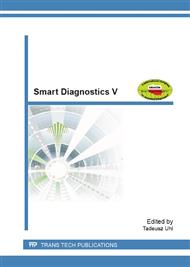[1]
B. D. Agarwal, L. J. Broutman and K. Chandrashekhara, Analysis and performance of fibre composites, Wiley, 2006.
Google Scholar
[2]
Deraemaeker, K. Worden, New trends in vibration based structural health monitoring, CISM Courses and Lectures, Vol.520, Springer-Verlag, 2010.
Google Scholar
[3]
K. Worden, G. Manson, N. R. Fieller, Damage detection using outlier analysis, Journal of Sound and Vibration, 229, 647–667, 1999.
DOI: 10.1006/jsvi.1999.2514
Google Scholar
[4]
C. M. Bishop, Neural networks for pattern recognition, Oxford University Press, 1995.
Google Scholar
[5]
C. M. Bishop, Pattern recognition and machine learning, Springer Press, 2006.
Google Scholar
[6]
M. A. Kramer, Nonlinear principal component analysis using auto-associative neural networks. AIChE Journal, 37(2):233–243, 1991.
DOI: 10.1002/aic.690370209
Google Scholar
[7]
K. Worden, Structural fault detection using a novelty measure, Journal of Sound and Vibration, 201(1), pp.85-101, 1997.
DOI: 10.1006/jsvi.1996.0747
Google Scholar
[8]
L. Tarassenko, A. Nairac, N. Townsend, I. Buxton, Z. Cowley, Novelty detection for the identification of abnormalities, International Journal of Systems Science, 31(11), pp.1427-1439, 2000.
DOI: 10.1080/00207720050197802
Google Scholar
[9]
H. Sohn, K. Worden, C.F. Farrar, Novelty detection under changing environmental conditions, SPIE's Eighth Annual International Symposium on Smart Structures and Materials, Newport Beach, CA. (LA-UR-01-1894), 2001.
DOI: 10.1117/12.434110
Google Scholar
[10]
N. Dervilis, R. Barthorpe, I. Antoniadou, W. J. Staszewski, K. Worden, Damage detection in carbon composite material typical of wind turbine blades using Auto-Associative Neural Networks, SPIE's Annual International Symposium on Smart Structures and Materials, 8348, 2012.
DOI: 10.1117/12.914710
Google Scholar
[11]
M. Scholz and R. Vig´ario. Nonlinear PCA: a new hierarchical approach. In M. Verleysen, editor, Proceedings ESANN, pages 439–444, 2002.
Google Scholar
[12]
Bourlard, H., & Kamp, Y., Auto-association by multilayer perceptrons and singular value decomposition. Biological Cybernetics, 59, 291–294, 1988.
DOI: 10.1007/bf00332918
Google Scholar
[13]
Cottrell, G. W., & Munro, P., Principal component analysis of images via back propagation. In Proceedings of the Society of Photo-Optical Instrumentation Engineers. Cambridge, MA, 1988.
Google Scholar
[14]
N. Japkowicz, S.J. Hanson, M.A. Gluck, Nonlinear autoassociation is not equivalent to PCA, Neural Computation 12, 531-545, Massachusetts Institute of Technology, 2000.
DOI: 10.1162/089976600300015691
Google Scholar
[15]
G. Manson, K. Worden, D. J. Allman. Experimental validation of a structural health monitoring methodology: Part III. Novelty detection on an aircraft wing, Journal of Sound and Vibration, 259 , 345–363, 2003.
DOI: 10.1006/jsvi.2002.5167
Google Scholar
[16]
P. Filzmoser, A multivariate outlier detection method, Proceedings of the 7th International Conference on Computer Data Analysis and Modeling, Minsk, Belarus,18-22, 2004.
Google Scholar
[17]
N. M. M. Maia, J. M. M Silva, Theoretical and experimental modal analysis, Research Studies Press, 1998.
Google Scholar
[18]
G. Manson, K.Worden, D. J. Allman, Experimental validation of a structural health monitoring methodology: Part II. Novelty detection on an aircraft wing, Journal of Sound and Vibration. 259, 345–363, 2003.
DOI: 10.1006/jsvi.2002.5167
Google Scholar
[19]
K. Worden, G. Manson, D. J. Allman, Experimental validation of a structural health monitoring methodology: Part I. Novelty detection on a laboratory structure, Journal of Sound and Vibration, 259, 323–343, 2003.
DOI: 10.1006/jsvi.2002.5168
Google Scholar
[20]
Stuart G. Taylor et al., Full-scale fatigue tests of CX-100 wind turbine blades. Part II: analysis, SPIE's Annual International Symposium on Smart Structures and Materials, 8348, 2012.
DOI: 10.1117/12.917493
Google Scholar
[21]
Kevin M. Farinholt et al., Full-scale fatigue tests of CX-100 wind turbine blades. Part I: testing, SPIE's Annual International Symposium on Smart Structures and Materials, 8343, 2012.
DOI: 10.1117/12.917493
Google Scholar
[22]
N Dervilis et al., Novelty detection applied to vibration data from a CX-100 wind turbine blade under fatigue loading, J. Phys.: Conf. Ser. 382 012047, 2012.
DOI: 10.1088/1742-6596/382/1/012047
Google Scholar
[23]
Ian T. Nabkey, Netlab algorithms for pattern recognition, Springer, 2004.
Google Scholar


